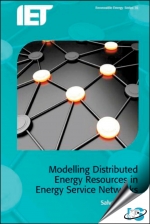The smart-grid concept can mean many things, however there is a consensus that its objective involves seamlessly adopting new technologies to existing infrastructures and maximising the use of resources. Modelling Distributed Energy Resources in Energy Service Networks focuses on modelling two key infrastructures in urban energy systems with embedded technologies. These infrastructures are natural gas and electricity networks and the embedded technologies include cogeneration and electric vehicle devices. The subject is addressed using a holistic modelling framework which serves as a means to an end; this end being to optimise in a coordinated manner the operation of natural gas and electrical infrastructures under the presence of distributed energy resources, thus paving the way in which smart-grids should be managed.
The modelling approach developed and presented in this book, under the name ‘time coordinated optimal power flow’ (TCOPF), functions as a decision maker entity that aggregates and coordinates the available DERs according to multiple criteria such as energy prices and utility conditions. The examples prove the TCOPF acts effectively as an unbiased intermediary entity that manages cost-effective interactions between the connected technologies and the distribution network operators. Therefore showcasing an integral approach on how to manage new technologies for the benefit of all stakeholders.
In addition, the book contains an innovative methodology of representing the temporal and spatial elements of electric vehicle mobility via agent based modelling. This representation is used to better portray how electric vehicles will influence power flows in electrical networks.
Engineers will value the easy to understand and detailed representation of old and new energy systems via mathematical equations that will allow them to develop and study their own scenarios of future energy systems.
Preface
Chapter 1 : Challenges in Effectively Managing Energy Resources, Infrastructures and Conversion Technologies
Chapter 2 : Integrated Modelling Review
Chapter 3 : Modelling of Energy Service Networks
Chapter 4 : Modelling Embedded Technologies in Energy Service Networks
Chapter 5 : Time-Coordinated Optimal Power Flow for Energy Service Networks
Chapter 6 : Modelling Electric Vehicle Mobility in Energy Service Networks
Index

























